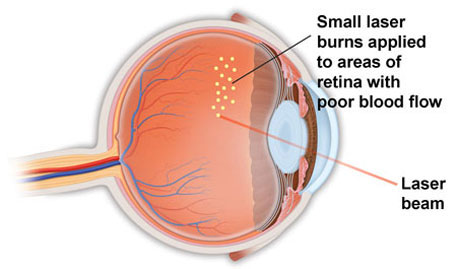
To view a PDF version of this information, click here.

Panretinal laser is a type of laser treatment used for abnormal blood vessels in various conditions of the retina that cause blood vessel damage, including diabetic retinopathy and retinal vascular occlusions. When blood vessel damage from these conditions is severe, the retina tries to compensate by growing new blood vessels. This is the retina's natural response to poor blood flow. Unfortunately, rather than helping the situation, these new blood vessels make things worse because they are abnormal and fragile and they rupture and bleed very easily. In very advanced forms of the above conditions, the abnormal blood vessels can even grow to the front of the eye, causing a severe glaucoma. Panretinal laser is applied to the peripheral retina where the blood flow is the poorest. This slows the growth of new abnormal blood vessels and usually causes existing abnormal blood vessels to shrink and wither away.
Before your procedure, the doctor will perform a dilated retina examination. Then, you will be seated comfortably in the procedure room and anesthetic eye drops will be placed in your eye. The laser will be performed either with you sitting upright at the slitlamp or with you reclining. A typical laser treatment is performed in 10 to 15 minutes. You will notice bright lights and typically feel a mild to moderate burning or stinging sensation. Immediately after the laser, your vision out of the treated eye will be dim and hazy for about 5 minutes. Then it will return to your pre-treatment level of vision. You will not need to wear a patch after the laser. If you experience a slight headache after your procedure, that can be normal and you may take Tylenol for it.
Your doctor will discuss all of the above with you and review additional information and precautions before and after your treatment. Our goal is to have all of your questions answered, so please feel free to ask our doctors and staff about any questions or concerns you may have.

